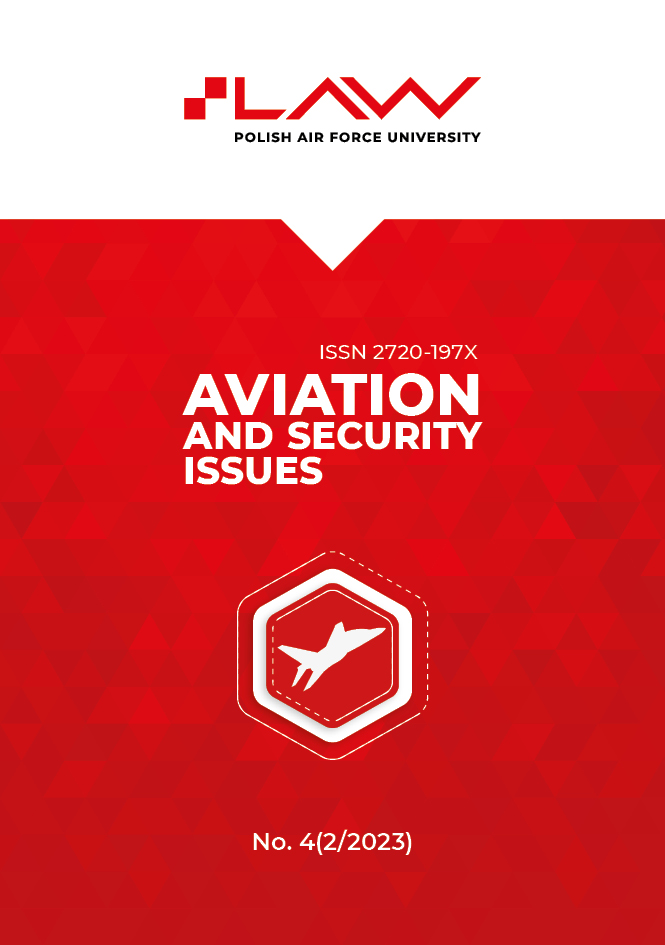OPTIMALISED PHYSICAL MODEL OF INERTIAL NAVIGATION SYSTEM AS EDUCATION SIMULATOR
Main Article Content
Abstract
This paper presents an educational simulator of an inertial navigation system built at the Air Force Institute of Technology. The article focuses on the presentation of the influence of instrumental errors of measurement elements on the calculation model, using interference simulation methods. Problems of diagnosing inertial navigation system malfunctions were analysed, covering older (gimballed) and modern (non-gimballed) solutions. The theoretical aspects of the performance of these systems are discussed, using matrix calculus and fault diagram. The main part of the paper presents the optimisation of the physical model of the navigation system, focusing on hardware, algorithms, and signal conditioning modules. The simulator demonstration includes the introduction of disturbances and error analysis of various aspects of the system. The summary points out the importance of the simulator test method for training avionics students, flight engineering service and pilots, considering it as an essential part of supporting the educational process in the field of integrated avionics systems.
Downloads
Article Details

This work is licensed under a Creative Commons Attribution-NonCommercial-NoDerivatives 4.0 International License.
References
Godha S., Lachapelle G., Foot Mounted Inertial System for Pedestrian Navigation. Measurement Science and Technology 19, no. 7 (May 2008): 075202. https://doi.org/10.1088/0957-0233/19/7/075202.
Gosiewski Z., Ortyl A., Algorytmy Inercjalnego Bezkardanowego Systemu Orientacji i Położenia Obiektu o Ruchu Przestrzennym. Vol. 12. Awionika. Wyd. Instytutu Lotnictwa, Warszawa 1999.
Grigorie T.L., Botez R.M., Modelling and Simulation Based Matlab/Simulink of a Strap-Down Inertial Navigation Systemów Errors Due to the Inertial Sensors. In Matlab Applications for the Practical Engineer. IntechOpen, 2014.
Izdebski M., Jacyna-Gołda I., Gołda P., Minimisation of the Probability of Serious Road Accidents in the Transport of Dangerous Goods. Reliability Engineering & System Safety 217 (2022): 108093.
Jiang Y.F., Lin Y.P., Error Analysis of Quaternion Transformations. IEEE Transactions of Aerospace and Electronic Systems 27, no. 4 (1991).
Kayton M., Fried W.R., Avionics Navigation Systems. 2nd Edition. A Wiley-Interscience Publication, 1997.
Lai J.Z., Liv P., Zhang L., Coning Error Analysis and Compensation in Rotation Inertial Navigation System (in Chinese). Journal of Nanjing University of Aeronautics and Astronautics 2 (2012): 159–64.
Lee H.K., Lee J.G., Roh Y.K., ParkC.G., Modeling Quaternion Error in SDINS: Computer Frame Approach. IEEE Transactions on Aerospace and Electronic Systems 34, no. 1 (1998).
Mytych J., Ligarski M.J., Expert Assessment of Conditions for Accredited Quality Management System Functioning in Testing Laboratories. Management Systems in Production Engineering 26, no. 1 (March 1, 2018): 42–48. https://doi.org/10.2478/mspe-2018-0007.
Rogala P., Statyczna Metoda Oceny Stanu Technicznego Systemu Nawigacji Inercjalnej. ITWL, 2023.
Savage P.G., Strapdown Inertial Navigation Integration Algorithm Design Part 1, Attitude Algorithms. Journal of Guidance, Control and Dynamics 21, no. 1 (1998).
Szelmanowski A., Borowski J., Poświata J., Rogala P., Symulator Diagnostyczny Dla Systemu Nawigacji Inercjalnej Wykorzystujący Statyczną Metodę Oceny Stanu Technicznego. In XI Konferencja Naukowa Bezpiecześstwa i Niezawodności KONBiN 2022, 07-10.06. Piekary Śląskie 2022.
Szelmanowski A., Michalak S., Borowski J., Cieślik A., Poświata J., Michałowski P., Kajewski P., Jaruga S., Chybowski M., Optymalizacja Zbudowanego w ITWL Modelu Fizycznego Systemu Nawigacji Zliczeniowej Klasy AHRS/INS w Zakresie Jego Konfiguracji Sprzętowej i Algorytmów Działania. BT ITWL, Warszawa 2021.
THALES, Functional Specification of Inertial Navigation System TOTEM-3000 / EGI-3000. Bordeaux, France 2010.
Yang Y., Song Y., Zhu Y., Innovation Research on Strapdown Inertial Navigation Technology. International Journal of Mechatronics and Applied Mechanics 2017 (January 1, 2017): 72–77.
Zieja M., Wawrzyński W., Tomaszewska J., Sigiel N., A Method for the Interpretation of Sonar Data Recorded during Autonomous Underwater Vehicle Missions. Polish Maritime Research 29, no. 3 (September 1, 2022): 176–86. https://doi.org/10.2478/pomr-2022-0038.

